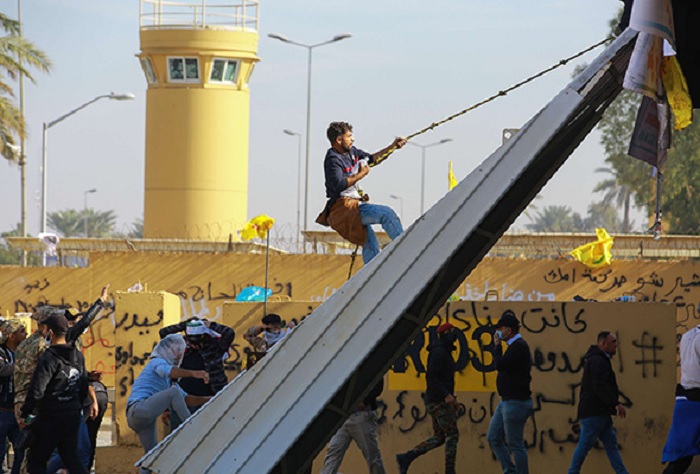
Sources say that the pro-Iran militias have about 10,000 troops ready to take control of the heart of the Iraqi government and foreign embassies there at any moment.
Security sources in Baghdad revealed the details of a plan that Iraqi militias affiliated with Iran have been implementing in Baghdad for months, with the aim of besieging the Iraqi capital’s Green Zone.
The Green Zone is the fortified area where the headquarters of the government, parliament, international missions and embassies, including the US Embassy, are located.
The plan’s disclosure comes amid relentless efforts by Prime Minister Mustafa al-Kadhimi to prevent the departure of the United Nations mission and the embassies of the United States and European and Gulf countries from the Iraqi capital due to serious security threats they are exposed to, including repeated missile attacks on foreign missions in the zone and a rise in terrorist operations targeting the convoys of international coalition forces in the war against ISIS.
Several Shia militias have strengthened their military presence in the Jadriya neighbourhood on the Rusafa side and in the Salhiya area on the Karkh side, under the pretext of protecting their headquarters from the threat of the widespread popular protest movement that began in October 2019.
The Green Zone is located between Jadriya and Salhiya along the Tigris River, and practically includes parts of them.
Jadriya, one of the most prestigious areas of Baghdad, is a favourite residence neighbourhood for militia leaders and their private offices, while the Iranian Embassy is located within the Salihiya area, meaning the militias’ military presence there is a foregone conclusion.
However, security sources say that, under the cover of protecting their headquarters from demonstrators, Iran-affiliated militias have been able to deploy nearly 4,000 militants in the vicinity of the Green Zone over the past months, bringing the number of unofficial militants to about 7,000.
If one takes into account the 3,000 militants of the Popular Mobilisation Forces (PMF) officially deployed inside the Green Zone now, the sources say the militias have about 10,000 troops ready to take control of the heart of the Iraqi government at any moment or storm any Arab or foreign embassy.
The sources confirm that Western and Arab embassies have a near accurate assessment of the situation, and have shared it with the Iraqi government, which has promised to take reassuring measures.
Kadhimi is moving to defuse the threat without resorting to a broad confrontation with the militias that official government forces may not be ready for yet.
The sources say that the United Nations sponsored, through its mission in Iraq, an effort to deliver messages to influential parties in the PMF on the security of foreign embassies. They explained that the United Nations Special Representative in Iraq, Jeanine Hennis-Plasschaert, informed these parties that several Arab and foreign missions are actually considering leaving Baghdad, pointing out the disastrous implications the development would have on the country.
On Wednesday evening, Iraqi Foreign Minister Fuad Hussein discussed with Hennis-Plasschaert in Baghdad “the developments in the situation in Iraq, especially enhancing security in vital areas.” The minister confirmed that his government “made great efforts to establish security” in vital areas, “including the Green Zone and the airport.” He also informed her of the results of his political meetings.
For her part, Hennis-Plasschaert reported on recent meetings with various Iraqi parties regarding political and security developments.
Hours later, Hussein held a meeting with the ambassadors of the European Union in Iraq during which he reviewed “the efforts of the Iraqi government in the field of securing foreign missions and facilitating their work in Iraq.”
Observers say that the security of international missions in Iraq will remain a major card in Iran’s hands as long as the militias affiliated with it have such a presence in the heart of the capital Baghdad and near government headquarters.
The Jadriya neighbourhood was the starting point for many attacks, particularly on the US Embassy, while sources reported that Iran’s Islamic Revolutionary Guard Corps (IRGC) had offices in the neighbourhood with weapons and espionage equipment stockpiled.
The sources recalled the bold operation carried out by the IRGC against Iraqi President Barham Salih’s palace, where it launched a drone to spy on consultations tasking Mustafa al-Kadhimi with forming a government,
These sources say that many militias have advanced headquarters in the Jadriya area, some of which have been used as detention centres where demonstrators and activists opposing Iranian influence in the country have been tortured.
 Eurasia Press & News
Eurasia Press & News



